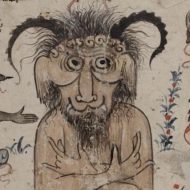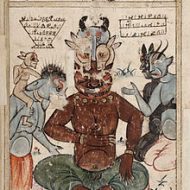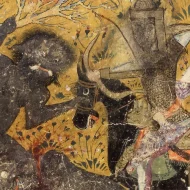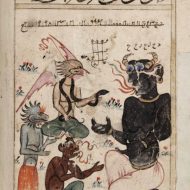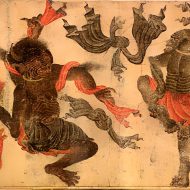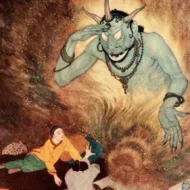Jinn : The Arabian Genie
At a glance
| Description | |
|---|---|
| Origin | Arabian Mythology |
| Classification | Ghosts |
| Family Members | N/A |
| Region | Middle East |
| Associated With | Shapeshifting, Evil, Granting wishes |
Jinn
Introduction
In Arabic mythology, the word jinn refers to a spirit that is unseen by humans, but capable of acting extraordinary powers. Beliefs in this spirit were common during pre-Islamic Arabia. The existence of these creatures was affirmed in the Qur’an. They are also regarded as beings of smokeless flame, similar to humans, who are capable of making their own decisions and facing the consequences of their actions.
The jinn have been regarded as some of the most popular figures in various folklore traditions, such as Egyptian, Persian, Turkish, and North African folklore. They have also appeared in various popular fiction, such as “The Thousand and One Nights.” In Indonesia and India, they have entered the Muslim imagination through the Qur’anic descriptions.
Physical Traits
Despite being made from a smokeless fire, the jinn and Iblis are similar to humans in that they have the freedom of action and moral judgement. In Islamic tradition, however, some of these creatures are regarded as devils. The Muslim imagination shows that the jinn inhabit a shadow world that is at the same time shared with and beyond humans. They can hear and see what people do, and they can influence people’s actions in a way that doesn’t align with their best interests.
Qareen, which is a type of jinn that lives in our midst, is one of several that people believe to be living in the earth. According to Arab traditions, the creatures were the original inhabitants of Earth, and they once ruled over other life forms such as Binn and the wind-like Hinn.
Despite being regarded as being spiritual and mysterious, the jinn are actually quite normal. They are known to eat, drink, and sleep, and they also have offspring that look exactly like their parents. Eventhough they’re not visible, some believe that the jinn possess bodies. According to the Zakariya al-Qazwini, the creatures are made of various parts of fire, and they can be found among humans, as well as other animals such as horses and cattle. In 1832, Sharif Ja’far wrote a book about the belief in the jinn in India. He states that their bodies are composed of 10% flesh and 90% spirit.
The only significant difference between the jinn and humans is their subtle matter. This allows them to move quickly and easily, and they can also cause and induce illnesses in humans. Because of this, people are urged to ally with these creatures through magical practices. In addition to being regarded as being spiritual and mysterious, the jinn are also known as gifted shapeshifters. In Islamic culture, some narratives refer to a serpent as a jinni. Other types of animals that are regarded as being related to the jinn include lizards and scorpions.
Other names
The word Jinn is a collective noun derived from the Semitic root of the word “jnn,” which literally means “to hide.” Some authors believe that the word means beings that are hidden from the senses. Other related words include the Arabic majnn, which literally means “possessed,” and the Arabic Jannah, which literally means “garden,” and “eden.” In Classical Arabic, the singular form of the word is referred to as jinn. Although the exact origin of the word jinn is not clear, some believe that it originated from the Latin genius, which is a guardian spirit in Roman religion. Others believe that it was derived from Aramaic ginnaya, which literally means “tutelary deity.”
Some believe that the word came from Persian folklore, in the form of an Avestic Jaini. They were believed to have been part of the mythology of ancient Iran. A derivative of the Latin genius’ name is the anglicized form of the word genie. It first appeared in the 18th-century in “The Thousand and One Night” as a way to refer to benevolent intermediaries. In literature, the word “demon” and “heavenly angels” are used to refer to malevolent spirits.
Powers and Abilities
According to folklore, these creatures are capable of assuming the form of an animal or human. They are believed to live in various objects, such as trees, stones, and the earth. They can also be killed, though they are free from physical restraints. The jinn are known to punish humans for their actions, which they consider to be harmful. They are also responsible for various accidents and diseases. But, through proper magic, human beings can use the powers of the jinn to their advantage.
In the Middle East, witchcraft is commonly associated with the presence of the jinn. In this way, a sorcerer can force a person to perform an order by calling a jinn. Usually, this type of action was carried out by means of invocation or by satisfying the spirit. The jinn are also considered to be assistants of certain psychics. They can be used to gather information about the past and present by revealing what’s been said in the past. One of the ways to subjugate them is to put a needle on their body or dress. Since they’re afraid of iron, the creatures can’t use their own power to remove it.
Modern Day Influence
With the rise of scientific rationalism, the belief in the jinn has become a metaphor for natural phenomena set aside for one of God’s most puzzling mysteries. Some believe that the creatures can’t physically possess humans, so they can only plant thoughts in one’s mind.
Although the exact nature of the jinn and their form are not clear, some Muslims believe that they are merely metaphorical beings. Others believe that denying their existence undermines one’s faith in Islam. Despite this, belief in the creatures still remains widespread, with many people still carrying out rituals and practices related to their existence.
Related Images
Frequently Asked Questions
What is lorem Ipsum?
I am text block. Click edit button to change this text. Lorem ipsum dolor sit amet, consectetur adipiscing elit. Ut elit tellus, luctus nec ullamcorper mattis, pulvinar dapibus leo.
What is lorem Ipsum?
I am text block. Click edit button to change this text. Lorem ipsum dolor sit amet, consectetur adipiscing elit. Ut elit tellus, luctus nec ullamcorper mattis, pulvinar dapibus leo.
What is lorem Ipsum?
I am text block. Click edit button to change this text. Lorem ipsum dolor sit amet, consectetur adipiscing elit. Ut elit tellus, luctus nec ullamcorper mattis, pulvinar dapibus leo.
What is lorem Ipsum?
I am text block. Click edit button to change this text. Lorem ipsum dolor sit amet, consectetur adipiscing elit. Ut elit tellus, luctus nec ullamcorper mattis, pulvinar dapibus leo.
What is lorem Ipsum?
I am text block. Click edit button to change this text. Lorem ipsum dolor sit amet, consectetur adipiscing elit. Ut elit tellus, luctus nec ullamcorper mattis, pulvinar dapibus leo.


